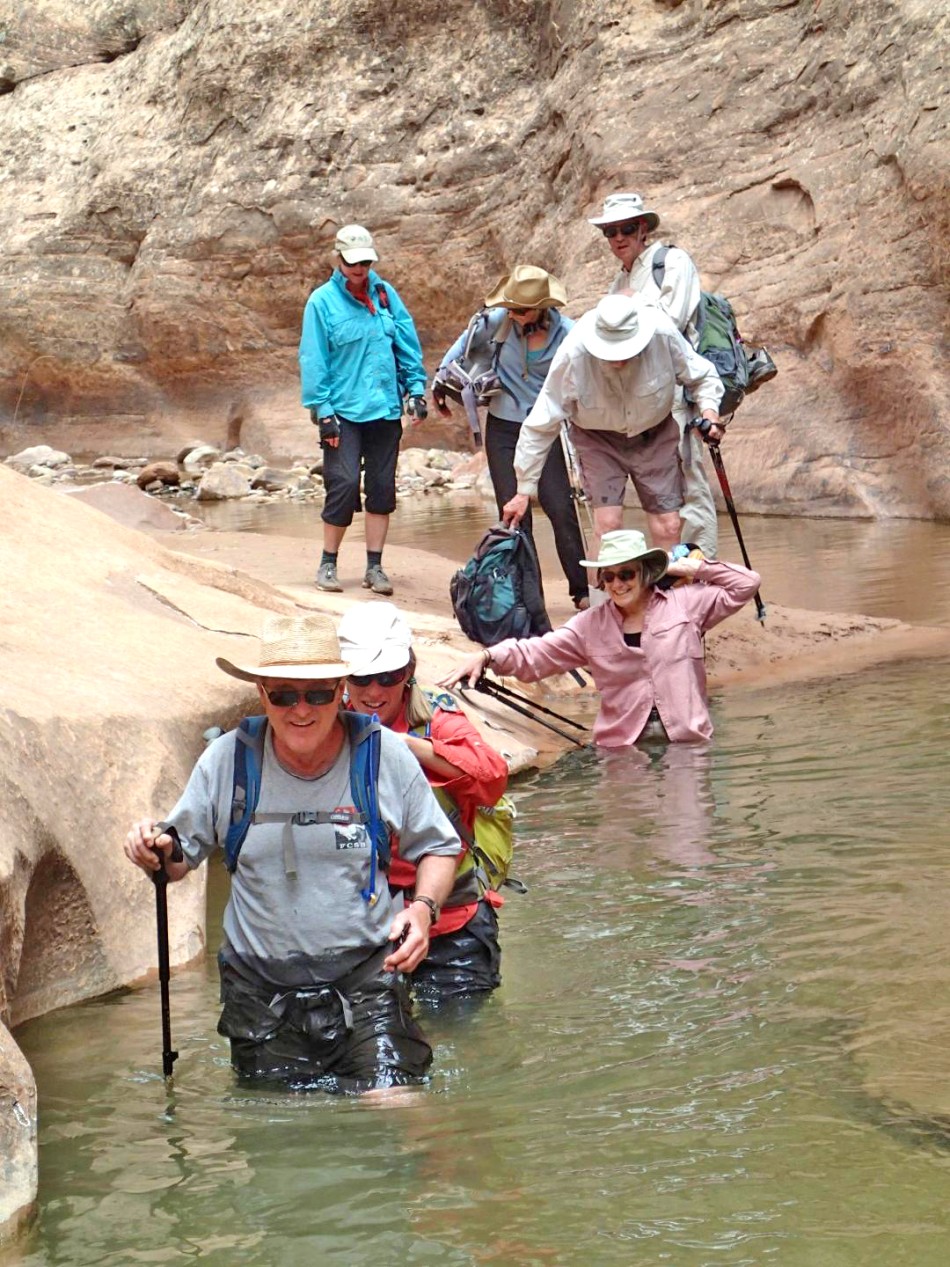 Los Alamos Mountaineers make their way down Hall’s Creek in 2014, front to back, Chris Foster, Mary Thompson, Joy Green, Ray Green, Terry Morgan, Marilyn Yeamans and Jackie Little, on an exploration of the Utah Canyon Country. Courtesy/Los Alamos Mountaineers
Los Alamos Mountaineers make their way down Hall’s Creek in 2014, front to back, Chris Foster, Mary Thompson, Joy Green, Ray Green, Terry Morgan, Marilyn Yeamans and Jackie Little, on an exploration of the Utah Canyon Country. Courtesy/Los Alamos Mountaineers
By BILL PRIEDHORSKY
Los Alamos Daily Post
The Los Alamos Mountaineers will celebrate their 70th anniversary Sept. 17, with activities including hiking, mountain biking, canyoneering, orienteering, and a gear demo, followed by a celebratory potluck at Urban Park.
Those 70 years began with a small group that met in a house in Western Area, and grew into adventures around the world. That history deserves – and will get – a full story, but we would like to share what the Mountaineers have been up to lately, as they have morphed into an all-purpose outdoor organization.
The purpose of the Mountaineers is the safe practice and enjoyment of outdoor activities. The club organizes outdoor activities and trips for the membership, and meets monthly to share outdoor experiences and adventures. In other words, the Mountaineers are about outdoor adventure for all.
By adventure, we do not mean a gratuitous quest for danger. Rather, adventure means challenge that builds new skills, mental and physical, heightens the senses, and takes one to places that many people never see.
Because we live in northern New Mexico, we are privileged to find outdoor adventure practically in our backyards. The Pajarito Plateau has a heritage of outdoor adventure that goes back to the pre-WWII boys school, and runs through the Manhattan Project days.
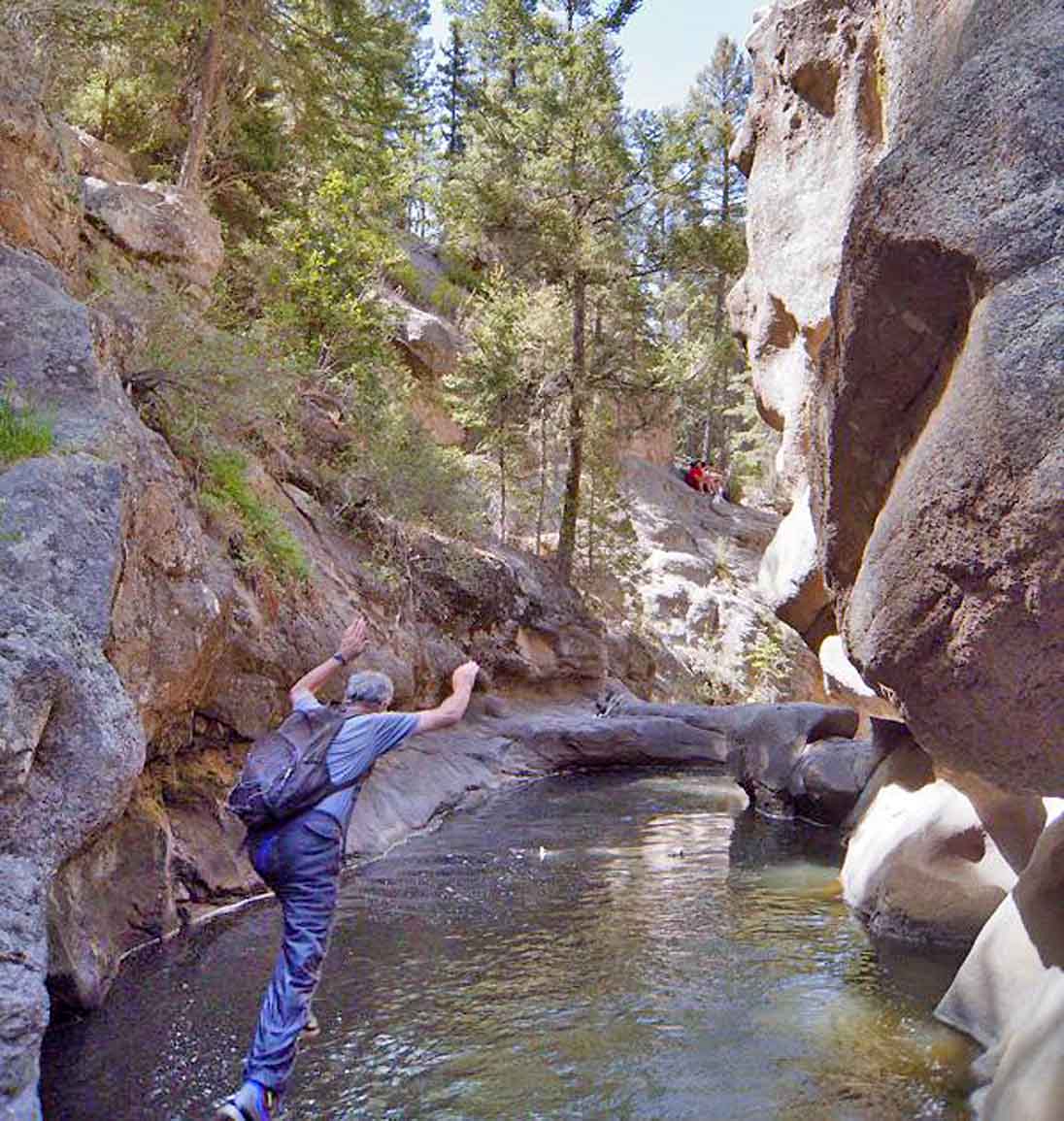 Mountaineer Jan Studebaker on a wet hike in 2011 down the East Fork of the Jemez River. Courtesy/Los Alamos Mountainers
Mountaineer Jan Studebaker on a wet hike in 2011 down the East Fork of the Jemez River. Courtesy/Los Alamos Mountainers
The Mountaineers talk about adventures, but the heart of the club is the doing. Starting from our home on the Pajarito plateau, the club spirals out to adventures near and far. There is much that can be done on a day trip: exploring for a day and coming home to sleep in one’s own bed. Adventures can be found on hiking trails, rough tracks, or no trails at all.
Closest to home are the canyons of the Pajarito Plateau, on which Los Alamos is built. The Mountaineers have taken moonlight hikes out to the end of the mesas, or gone farther afield to the wilderness of Bandelier, where much the same topography is in its wild, natural state.
Although Bandelier’s forests were severely damaged by 2011 Las Conchas Fire, it is also a more open and scenic. The Mountaineers hike across Bandelier landscapes to the distant mesas, cruise the canyons, and explore the nooks and crannies of narrow slot canyons.
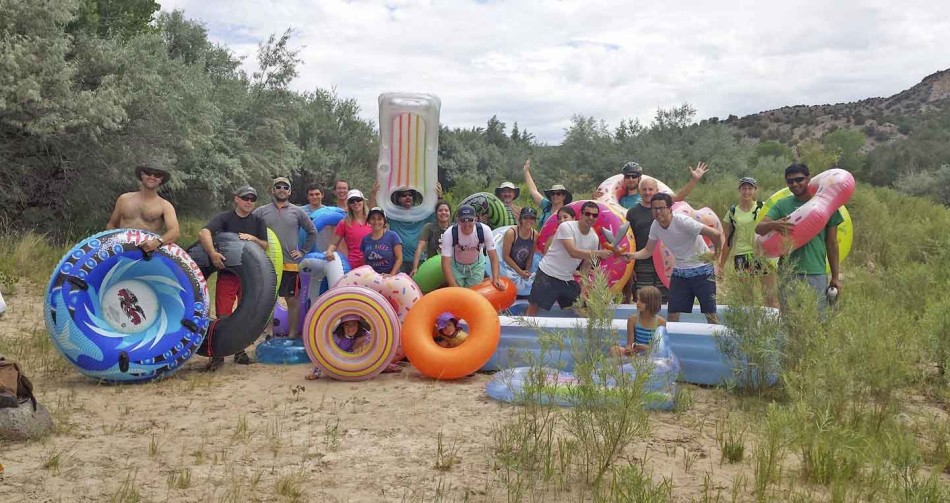 Setting out for a day on the water in 2017 – the Rio Grande below White Rock. Courtesy/Los Alamos Mountainers
Setting out for a day on the water in 2017 – the Rio Grande below White Rock. Courtesy/Los Alamos Mountainers
Many a hike explores the meadows and valleys of the Jemez Mountains, in both National Forest and the Valles Caldera National Preserve. A typical hike will explore the big views across the meadows, but the Jemez also features the Jemez River. When not closed for fire danger, a wet hike down the Jemez River is great way to mitigate the hottest days of the summer.
 Talus Canyon above Ghost Ranch in 2020, near Abiquiu. Courtesy/Los Alamos Mountaineers
Talus Canyon above Ghost Ranch in 2020, near Abiquiu. Courtesy/Los Alamos Mountaineers
Every July, the Mountaineers beat the heat with a Rubber Ducky float. Usually with a crew of Laboratory summer students in tow, the crew starts in La Senda, hikes down the Red Dot trail to the Rio Grande then upstream a couple miles, then floats back to Red Dot. The flotilla is a motley mix, ranging from the latest stand up paddleboards to the cheapest inflatable ring to be bought at the grocery for a few dollars.
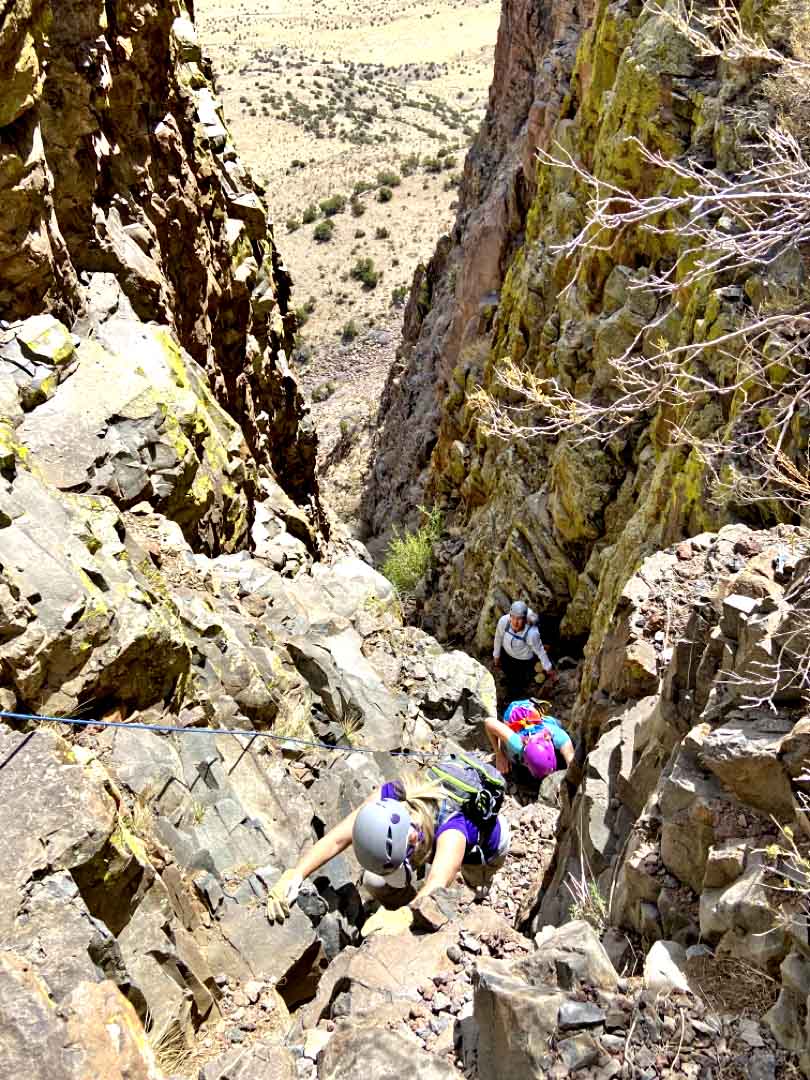 The hardest part of the way to the top of Cabezon Peak. Courtesy/Los Alamos Mountaineers
The hardest part of the way to the top of Cabezon Peak. Courtesy/Los Alamos Mountaineers
Come summer and fall, when the heat has abated, it is time to explore the high desert country of northern New Mexico. Abiquiu, Nambe Badlands, Ojitos Wilderness, Red Wash, or the trails off the highway from Espanola to Abiquiu are a few of the destinations that the Mountaineers explore. These offer a mix of the Jemez volcanic terrain with the sedimentary rock of the Colorado Plateau. Plateau terrain starts just past the village of Abiquiu, and there are even a few slot canyons, like one would find in the red rock country of Utah. A typical Abiquiu hike might begin at Ghost Ranch headquarters, setting out on an advertised trail, but then go cross-country across the mesas and through the canyons, discovering unadvertised places like the narrow slot of Talus Canyon.
Another place for desert adventure is the volcanic plug field southwest of the Jemez Mountains, where the eroded cores of extinct volcanoes dot the landscape. Some of their summits are easy, and some a rock climb. The classic peak of Cabezon Peak can be reached by a semi-technical route, as shown in the figure – a little steeper than a hike, but straightforward enough with a little rope assistance for the less experienced.
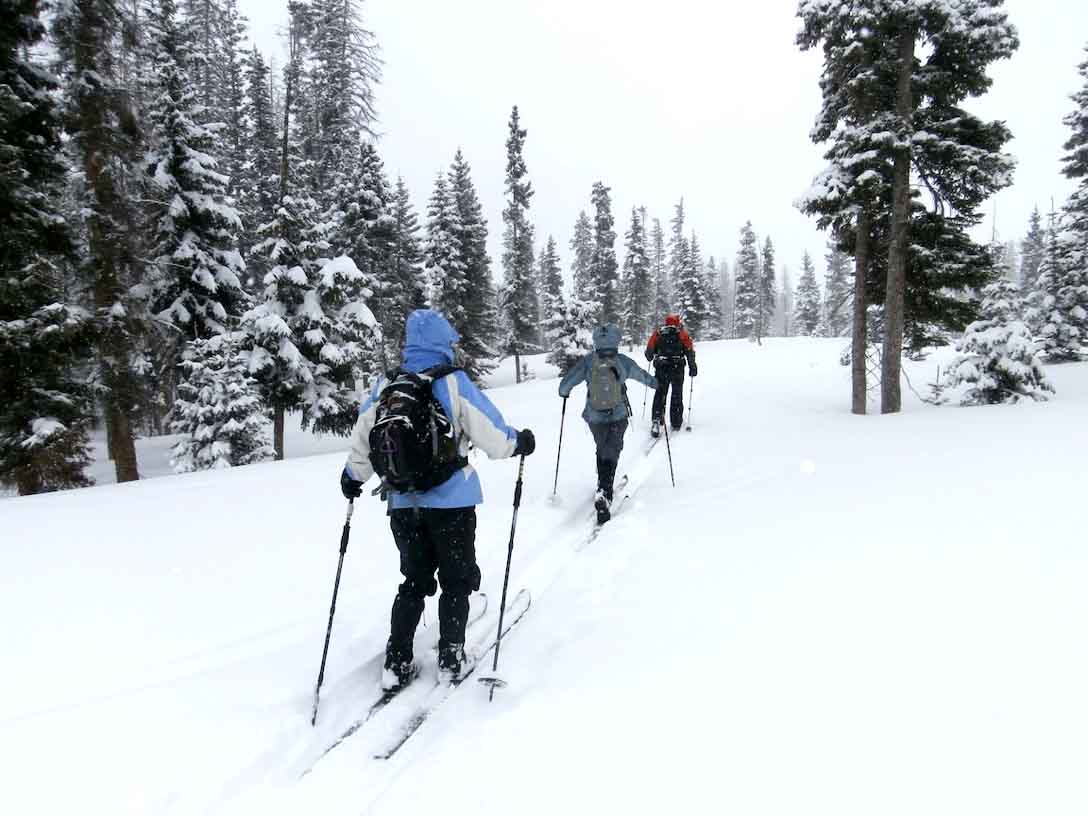 Cross-country skiing Grouse Creek near Cumbres Pass. Courtesy/Los Alamos Mountaineers
Cross-country skiing Grouse Creek near Cumbres Pass. Courtesy/Los Alamos Mountaineers
Winter is no cause to stop exploring the out of doors. Rather, it is time to pull out different gear, and do new things. The Mountaineer schedule does not slow down for winter. On a good year, the Jemez Mountains offer cross-country skiing in the Valles Preserve and beyond. When snow is sparse, as happens too often in recent years, an answer is at hand: drive less than two hours north to the Cumbres Pass area, where snow is much more reliable, as in the day excursion to Grouse Creek shown in the photo.
The Mountaineers also organize multi-sport winter outings, typically based in a vacation rental in a town like Pagosa Springs, Durango, or Salida, then heading out for the day to alpine ski resorts or back country trails, to cross-country ski or snowshoe.
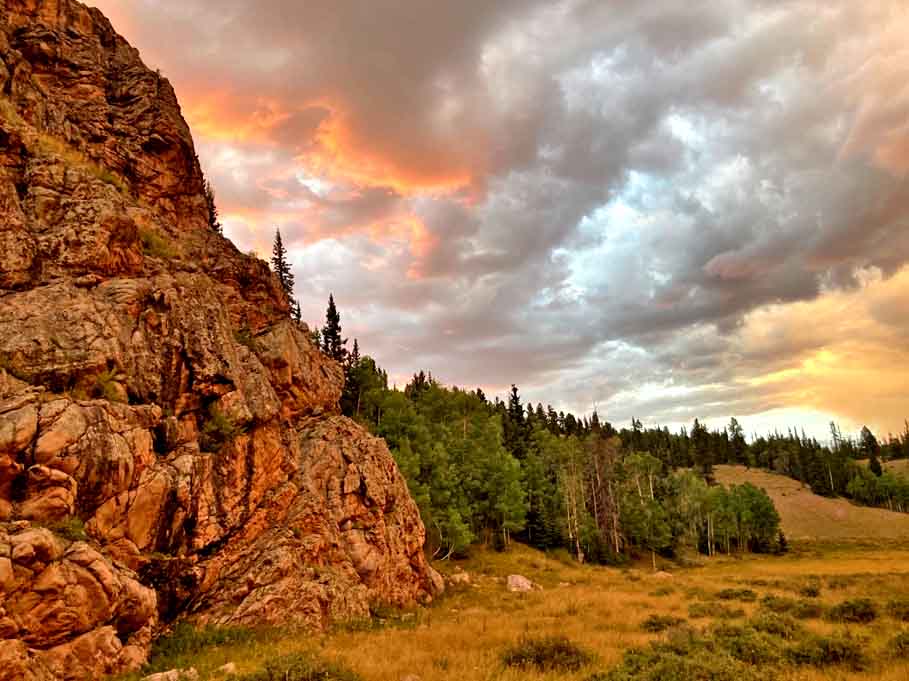 View from a backpacking camp in 2021 in Cruces Basin, near the Colorado border. Courtesy/Los Alamos Mountaineers
View from a backpacking camp in 2021 in Cruces Basin, near the Colorado border. Courtesy/Los Alamos Mountaineers
Springs, Durango, or Salida, then heading out for the day to alpine ski resorts or back country
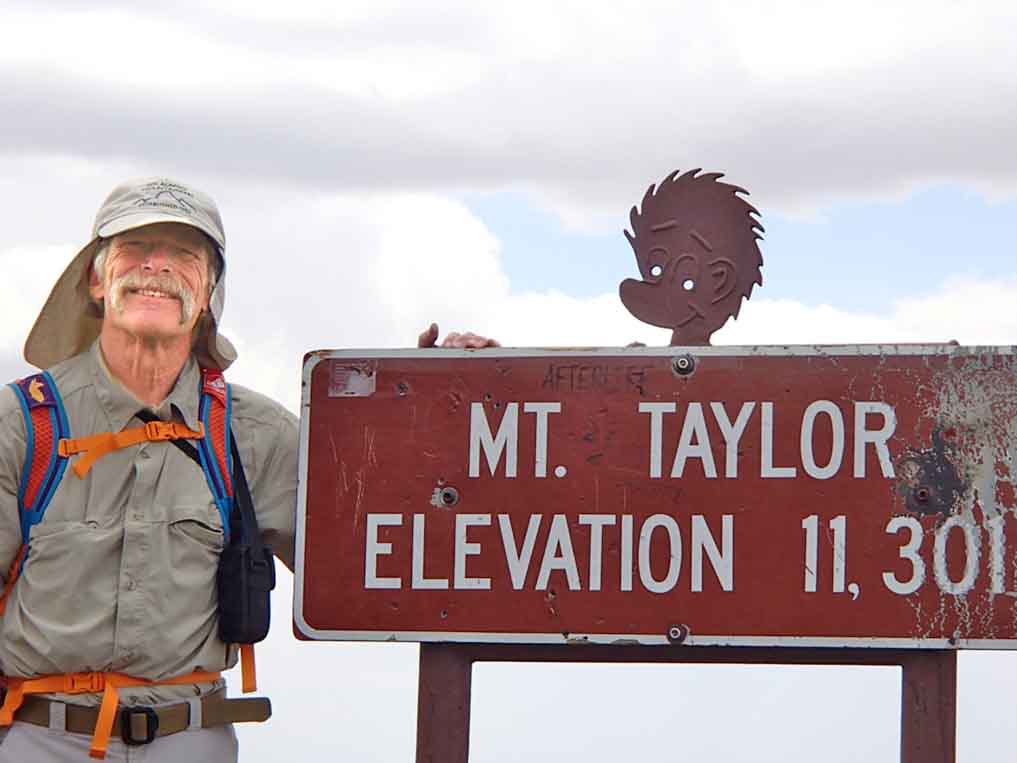 Evan Rose in 2019 atop a New Mexico summit. Courtesy/Los Alamos Mountaineers
Evan Rose in 2019 atop a New Mexico summit. Courtesy/Los Alamos Mountaineers
Destinations that can be reached in a day are just a start. At a greater distance can be found mountain and desert destinations throughout the greater Southwest. The Mountaineers offer backpack trips into the mountains in New Mexico and Colorado. A favorite, easy destination is the high ridges and meadows of the Cruces Basin Wilderness, near the Colorado state line, and within sound of the Cumbres-Toltec Railway’s whistle. The streams are full of trout, and the sunsets magnificent.
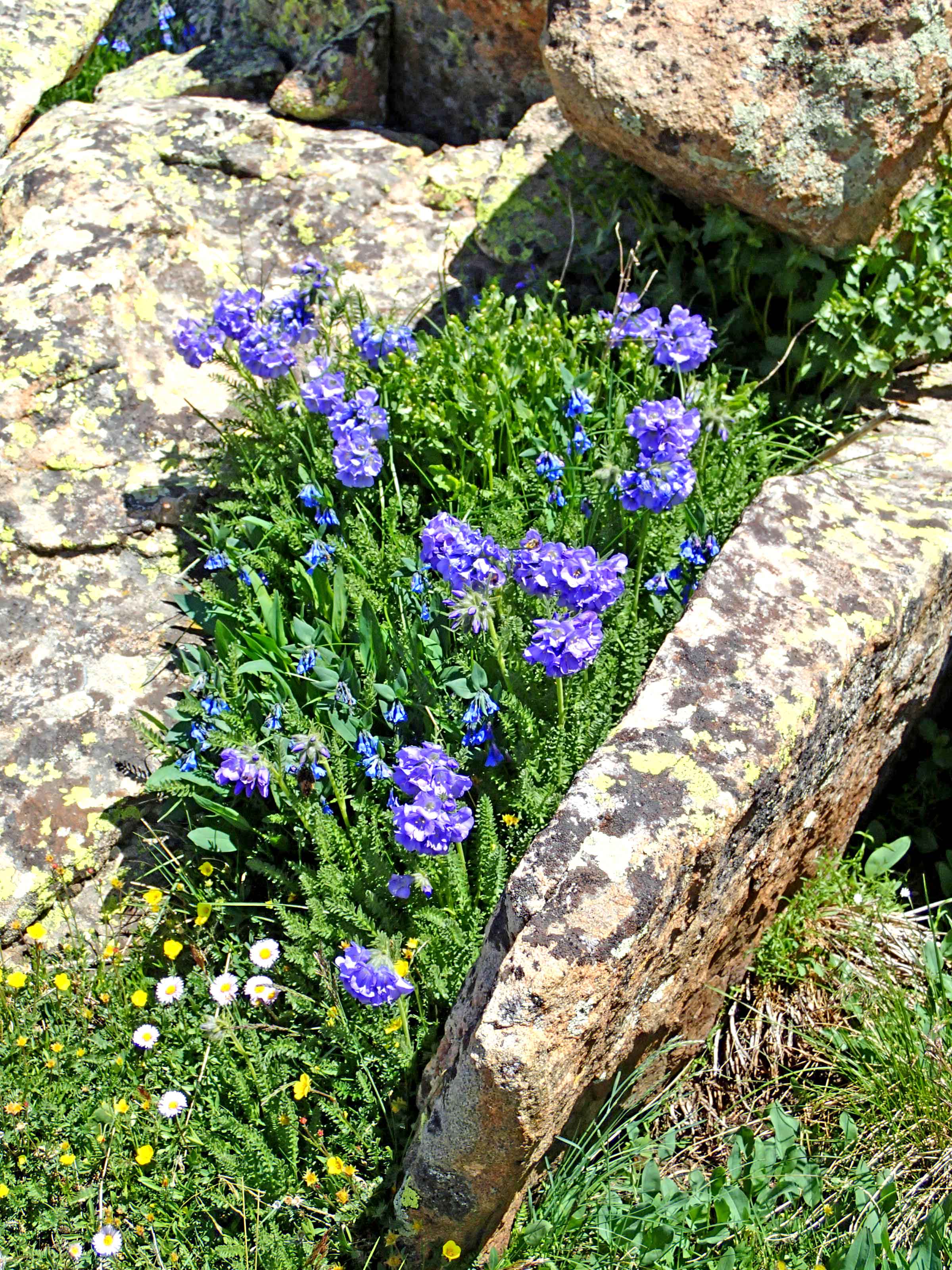
The New Mexico mountains offer high alpine summits not far from home. Lake Peak, Santa Fe Baldy, Jicarita Peak, and Wheeler Peak are goals for day outings; other destinations, like Mount Taylor, require an overnight, perhaps at the trailhead. Although the highest peak in New Mexico, Wheeler Peak, caps out at 13,162 feet, 14,000-foot summits start just past the Colorado border. Several Mountaineers have, or are in the process of, climbing all 53 of them.
A convivial way to explore the Colorado high country is to rent a back country hut. These rustic lodgings, which can hold up to 16, have fantastic high mountain views out their windows. Out the front door is the high country wilderness. The Mountaineers are just back from a trip to Uncle Bud’s hut in the Tenth Mountain division system. Galena Peak, overlooking the hut at 12,896 feet, was an irresistible destination. Its summit, although not that high for a Colorado peak, nonetheless had a top-of-the world feeling, with something like 15 fourteener peaks visible in the distance.
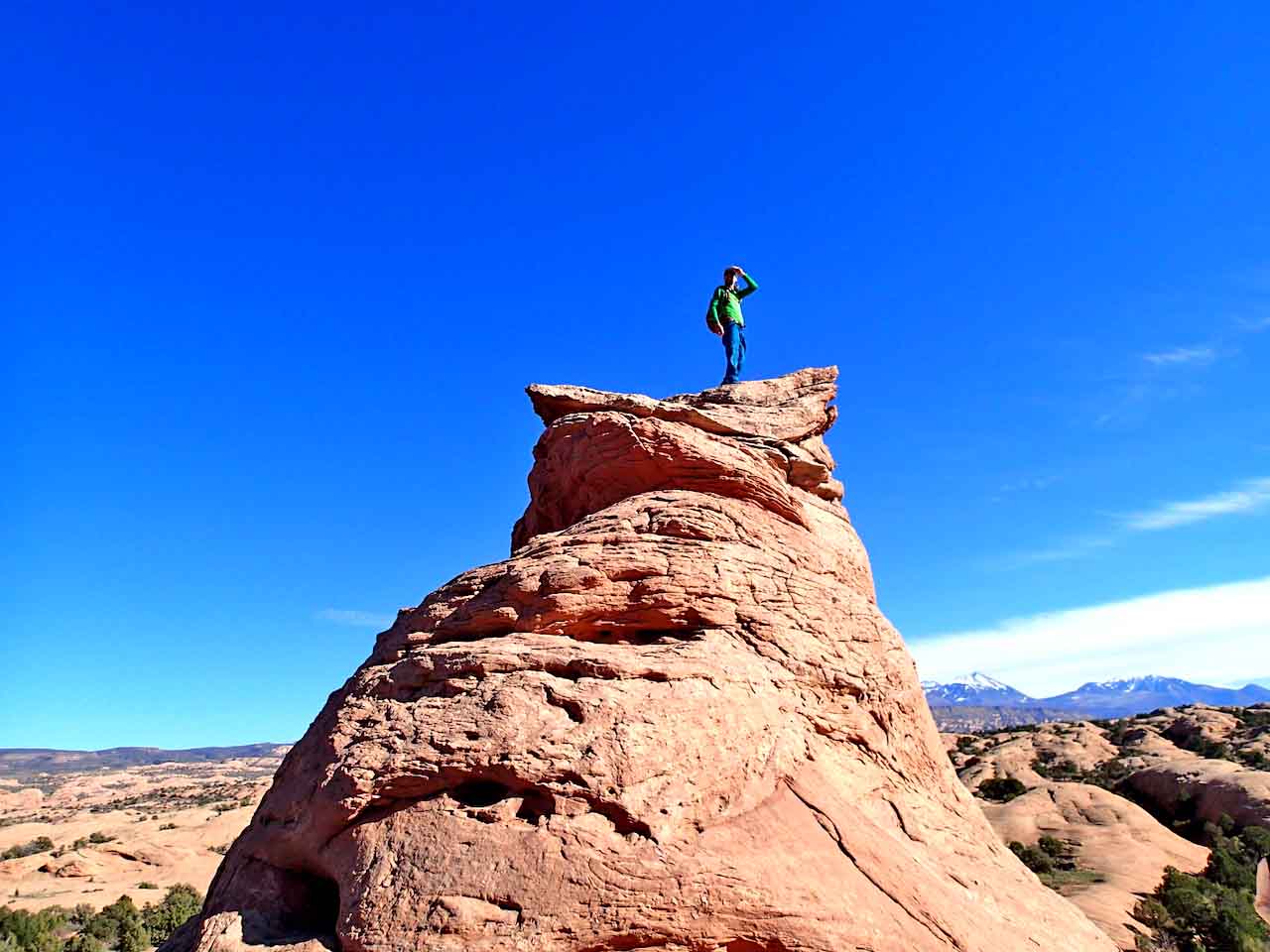 Exploring in 2021 in Arches National Park, from a base in Moab, Utah. Courtesy/Los Alamos Mountaineers
Exploring in 2021 in Arches National Park, from a base in Moab, Utah. Courtesy/Los Alamos MountaineersColorado is not the limit for the Mountaineers ambitions. Travel northwest, and one enters the Colorado Plateau, roughly centered on the Four Corners junction of New Mexico, Arizona, Colorado, and Utah. In the words of author Edward Abbey: “The canyon country of southern Utah and northern Arizona – the Colorado Plateau – is something special. Something strange, marvelous, full of wonders. As far as I know there is no other region on earth much like it, or even remotely like it. Nowhere else have we had this lucky combination of vast sedimentary rock formations exposed to a desert climate, a great plateau carved by major rivers-the Green, the San Juan, the Colorado-into such a surreal land of form and color.”
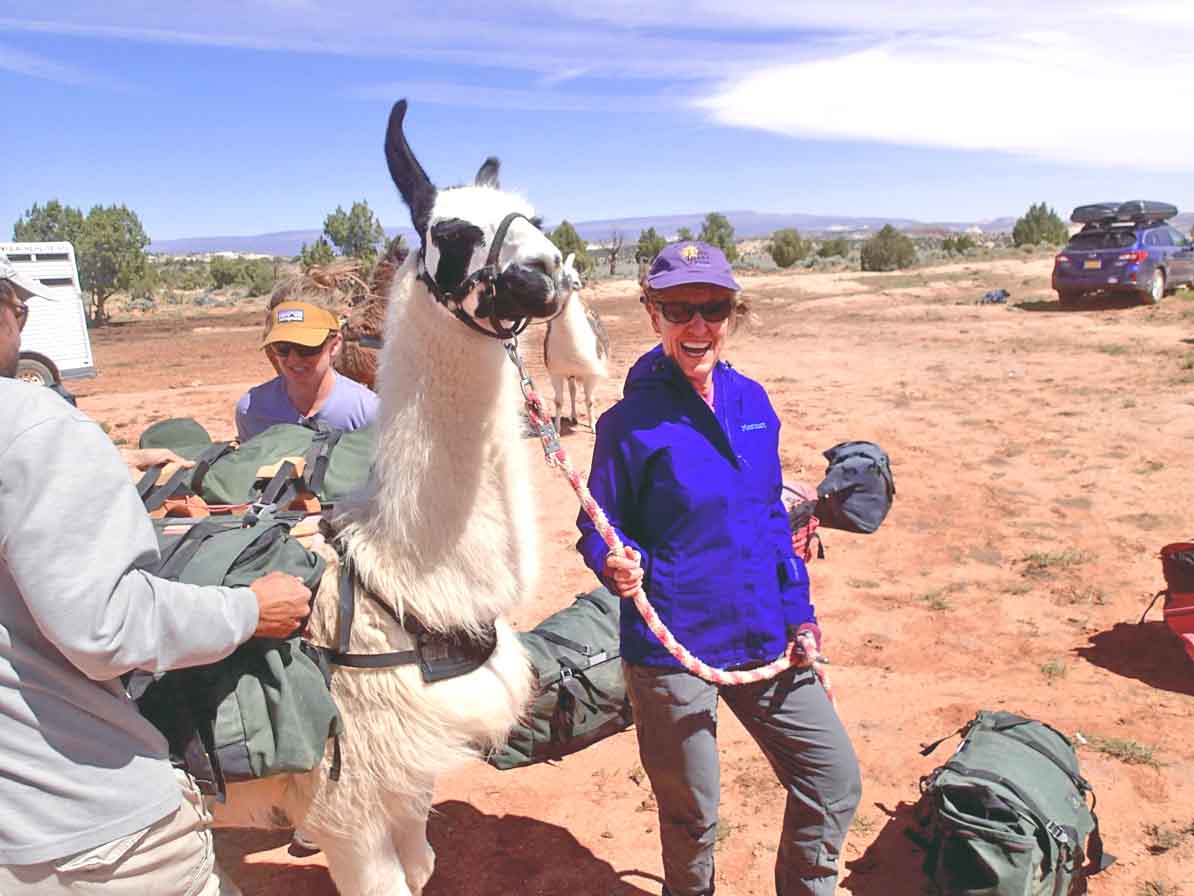 Llama helper Karen Grace preparing to carry the Mountaineers’ gear to a wilderness camp in May 2017 above Escalante, Utah. Courtesy/Los Alamos Mountaineers
Llama helper Karen Grace preparing to carry the Mountaineers’ gear to a wilderness camp in May 2017 above Escalante, Utah. Courtesy/Los Alamos Mountaineers
The Mountaineers orginally explored the Canyon Country by backpacking, but have now found more comfortable ways to explore. Some of their trips are based in the small towns of southeastern Utah, like Moab, Bluff, Blanding, Escalante, and Torrey, staying in a vacation rental and heading out to explore on a daily basis. Other trips go into the wilderness, accepting the help of a llama packer to carry gear into a wilderness camp. From such a camp, equipped with the simple luxuries of folding tables, a two-burner stove, camp chairs, and a wine cellar, one can explore out into the bare rock canyons and domes (slickrock), finding new wonders around every corner.
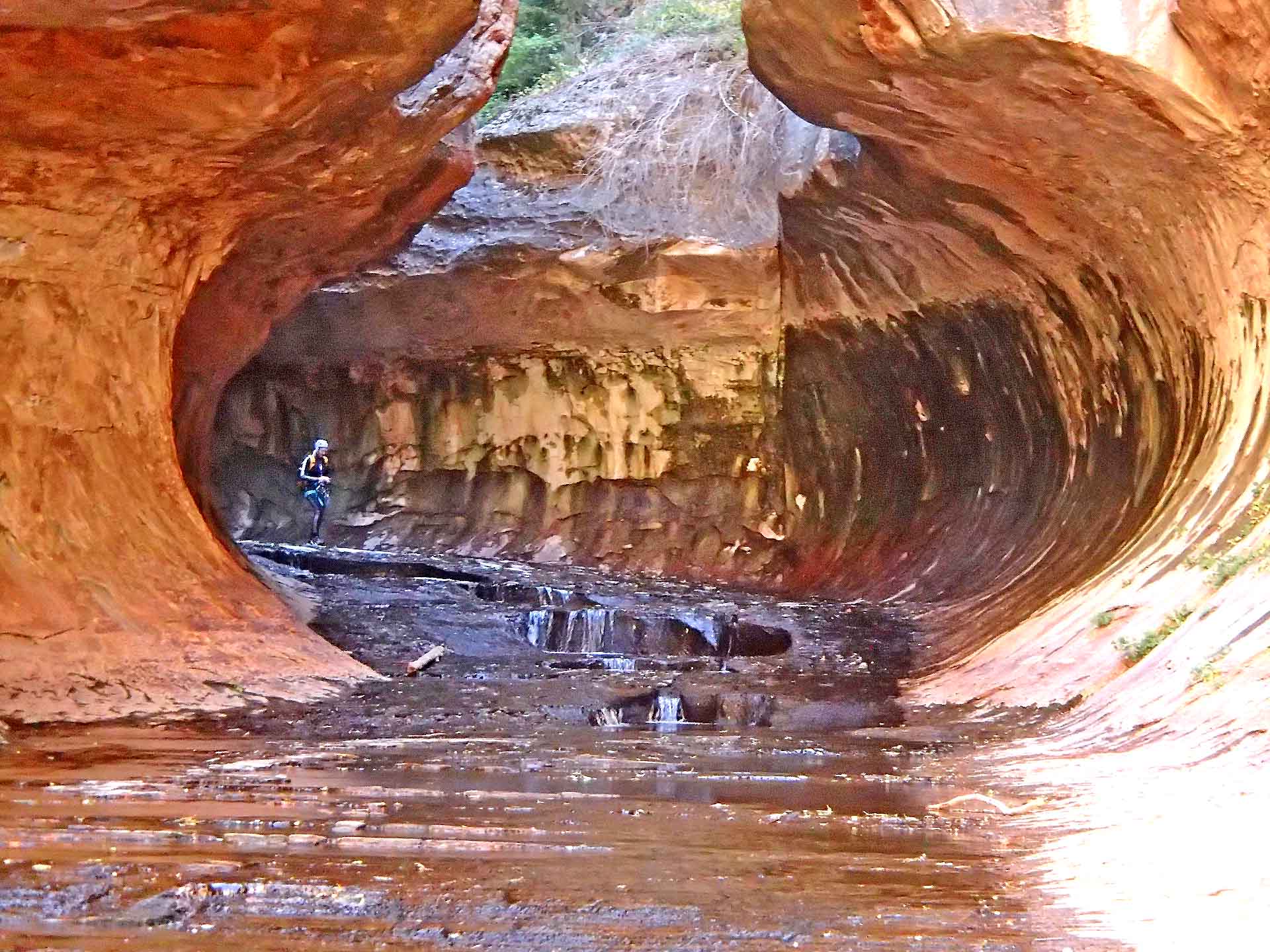 Canyoneering in ‘the Subway’ in October 2017 at Zion National Park. Courtesy/Los Alamos Mountaineers
Canyoneering in ‘the Subway’ in October 2017 at Zion National Park. Courtesy/Los Alamos Mountaineers
The Mountaineers have embraced canyoneering as a way to adventure in the Canyon Country. Canyoneering is the exploration of narrow canyons, sometimes so narrow that one can barely squeeze through, using technical means. The party starts at the top of a canyon and descends over cliffs and waterfalls by rope. One rappels by lowering oneself down a rope with specialized hardware attached to a harness; it is exhilarating, but actually quite safe. Such means can take the canyoneer to places that no one else can every see.
Because outdoor activities were among the safest things to pursue during the pandemic, the Mountaineers remained an oasis of community and support. Their activities continued almost unimpeded. Pandemic or not, sharing outdoor activities, spending days together doing challenging things, builds friendships that can last a lifetime.
All are welcome to join the Mountaineers. The club can be found at lamountaineers.org. Meetings are held the 4th Tuesday of the month at the Nature Center, in partnership with the Pajarito Environmental Education Center. And don’t forget the 70th anniversary party – contact lam70anniversary@googlegroups.com!

